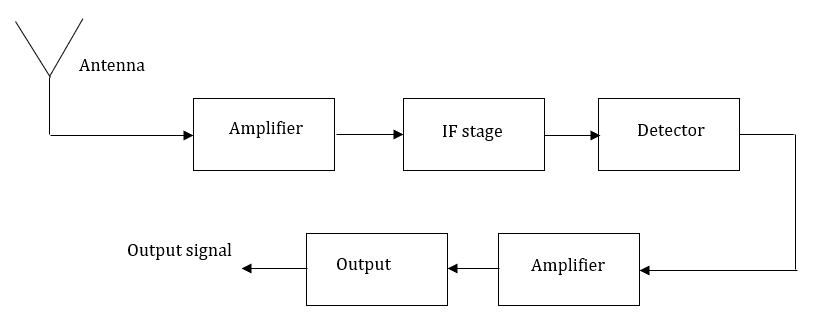
Draw a neat labelled diagram of the receiver.
Answer
580.2k+ views
Hint: The receiver has an antenna to receive the signal and then signal passes through an amplifier to amplify the signals received which then passes through the Intermediate frequency stage . After passing through the intermediate frequency stage we pass the signals through the detector after which the detected signals are amplified and sent to the output
Complete step by step answer:
The diagram of the receiver system can be drawn as below:

The transmitted message gets attenuated in propagating through the channel. That is why we have an amplifier and a detector after the antenna. In addition, to facilitate further processing, the carrier frequency is usually changed to a lower frequency through an intermediate frequency (IF) stage preceding the detection. The detected signal may not be strong enough to become useful and hence it is required.
The process of recovering the modulating signal from the modulated carrier wave is called detection. In order to obtain the original message signal m(t) of certain angular frequency, a simple method is shown in the form of a block diagram above.
Note:
The antenna receives the signal and the received signal is amplified using an amplifier as the received signal is usually a weak signal and the amplified signal is passed through an intermediate frequency stage where the signal is multiplied with the signal generators present at the receiver and then the signals are passed through the detector to get the signals corresponding to the each bit and then the detected signal waves is passed through the amplifier to make the signals transferable and finally we get the output from the amplifier .
Complete step by step answer:
The diagram of the receiver system can be drawn as below:

The transmitted message gets attenuated in propagating through the channel. That is why we have an amplifier and a detector after the antenna. In addition, to facilitate further processing, the carrier frequency is usually changed to a lower frequency through an intermediate frequency (IF) stage preceding the detection. The detected signal may not be strong enough to become useful and hence it is required.
The process of recovering the modulating signal from the modulated carrier wave is called detection. In order to obtain the original message signal m(t) of certain angular frequency, a simple method is shown in the form of a block diagram above.
Note:
The antenna receives the signal and the received signal is amplified using an amplifier as the received signal is usually a weak signal and the amplified signal is passed through an intermediate frequency stage where the signal is multiplied with the signal generators present at the receiver and then the signals are passed through the detector to get the signals corresponding to the each bit and then the detected signal waves is passed through the amplifier to make the signals transferable and finally we get the output from the amplifier .
Recently Updated Pages
A man running at a speed 5 ms is viewed in the side class 12 physics CBSE

The number of solutions in x in 02pi for which sqrt class 12 maths CBSE

State and explain Hardy Weinbergs Principle class 12 biology CBSE

Write any two methods of preparation of phenol Give class 12 chemistry CBSE

Which of the following statements is wrong a Amnion class 12 biology CBSE

Differentiate between action potential and resting class 12 biology CBSE

Trending doubts
What are the major means of transport Explain each class 12 social science CBSE

Which are the Top 10 Largest Countries of the World?

Draw a labelled sketch of the human eye class 12 physics CBSE

How much time does it take to bleed after eating p class 12 biology CBSE

Explain sex determination in humans with line diag class 12 biology CBSE

Explain sex determination in humans with the help of class 12 biology CBSE




